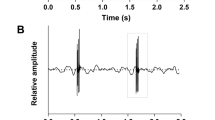Abstract
The importance of chemical cues for transmitting information concerning sexual identity, agonistic state, and stress-related condition in the crayfishProcambarus clarkii (Girard) was examined in a flow-through system. Experiments tested the effects of “conditioned water” from stimulus tanks on the behavior of solitary male or female crayfish. Twenty males and 20 females were subjected to a random sequence of five treatments: unconditioned water (control), conditioned water flowing through tanks containing a solitary male or female, and conditioned water from tanks holding either two males or two females. Durations of the following behaviors were recorded: chelae up, chela(e) in baffle hole, chela waving, climbing, digging, grooming, gross body movement, and meral spread. Results indicated that crayfish chemically detected another animal within 0.25 m without additional visual or tactile stimuli; however, crayfish apparently did not “communicate” information on sexual identity, agonistic state, or stress condition, nor does this detection necessarily imply discrimination between stimuli from crayfish and other taxa (e.g., fish). Our conclusions are contrasted with the two previous reports on chemical communication in crayfish in which experimental animals were tested in static systems. We suggest that a temporal separation of molting and copulation and a long reproductive receptivity period for females (which would allow abundant intersexual encounters) could account for a lack of selective pressure to evolve long-distance sex pheromones.
Similar content being viewed by others
References
Ameyaw-Akumfi, C.E. 1976. Some aspects of breeding biology of crayfish. PhD dissertation, University of Michigan, Ann Arbor. 252 pp.
Ameyaw-Akumfi, C., andHazlett, B.A. 1975. Sex recognition in the crayfishProcambarus clarkii.Science 190:1225–1226.
Bossert, W.H., andWilson, E.O. 1963. The analysis of olfactory communication among animals.J. Theor. Biol. 5:443–469.
Bovbjerg, R.V. 1970. Ecological isolation and competitive exclusion in two crayfish (Orconectes virilis andOrconectes immunis).Ecology 51:225–236.
Burghardt, G.M. 1970. Defining “communication”, pp. 5–18,in J.W. Johnston, Jr., D.G. Moulton, and A. Turk (eds.). Advances in Chemoreception, Vol. I, Communication by Chemical Signals. Appleton-Century-Crofts, New York.
Chidester, F.E. 1912. The biology of the crayfish.Am. Natur. 46:279–293.
Dahl, E., Emanuelsson, H., andvon Mecklenburg, C. 1970a. Pheromone reception in males of the amphipodGammarus duebeni Lilljeborg.Oikos 21:42–47.
Dahl, E., Emanuelsson, H., andvon Mecklenburg, C. 1970b. Pheromone transport and reception in an amphipod.Science 170:739–740.
Dunham, P.J. 1978. Sex pheromones in Crustacea.Biol. Rev. 53:555–583.
Kamiguchi, Y. 1972. Mating behavior in the freshwater prawn,Palaemon paucidens. A study of the sex pheromone and its effect on males.J. Fac. Sei. Hokkaido Univ. Ser. VI, Zool. 18:24–31.
Karlson, P., andLüscher, M. 1959. ‘Pheromones’: A new term for a class of biologically active substances.Nature 183:55–56.
Little, E.E. 1975. Chemical communication in maternal behavior of crayfish.Nature 255:400–401.
Mason, J.C. 1970. Copulatory behavior of the crayfish,Pacifastacus trowbridgii (Stimpson).Can. J. Zool. 48:969–976.
Pearse, A.S. 1909. Observations on copulation among crawfishes with special reference to sex recognition.Am. Natur. 43:746–753.
Penn, G.H., Jr. 1943. A study of the life history of the Louisiana red-crawfish,Cambarus clarkii Girard.Ecology 24:1–18.
Templeman, W. 1934. Mating in the American lobster.Contrib. Can. Biol. Fish. 8:423–432.
Templeman, W. 1936. Further contributions to mating in the American lobster.J. Biol. Board Can. 2:223–226.
Thorp, J.H. 1978. Agonistic behavior in crayfish in relation to temperature and reproductive period.Oecologia 36:273–280.
Thorp, J.H., andAmmerman, K.S. 1978. Chemical communication and agonism in the crayfishProcambarus acutus aculus.Am. Midl. Natur. 100:471–474.
Wilson, E.O., andBossert, W.H. 1963. Chemical communication among animals.Rec. Prog. Horm. Res. 19:673–716.
Wilson, E.O. 1970. Chemical communication within animal species, pp. 133–155,in E. Sondheimer and J. B. Simeone (eds.). Chemical Ecology. Academic Press, New York.
Author information
Authors and Affiliations
Rights and permissions
About this article
Cite this article
Itagaki, H., Thorp, J.H. Laboratory experiments to determine if crayfish can communicate chemically in a flow-through system. J Chem Ecol 7, 115–126 (1981). https://doi.org/10.1007/BF00988639
Received:
Revised:
Issue Date:
DOI: https://doi.org/10.1007/BF00988639




